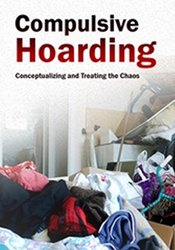

A Complex and Unique Disorder
Previous treatments for hoarding have been vastly ineffective due in part to a lack of formal definition of the diagnostic criteria, deficits of applied research, faulty case conceptualization, and scant treatment interventions. With the recent release of the DSM-5, in which Hoarding Disorder has finally been identified as its own disorder, appropriate clinical treatment interventions can now be guided by these revisions. The continual increase of media attention brings an onslaught of clients seeking clinical interventions from professional mental health care providers who are vastly unprepared to treat this rapidly growing and misunderstood population. Although hoarding has traditionally been considered a symptom dimension within OCD and OCPD, recent research findings has proved otherwise and led to the latest DSM-5 revisions. Patients who hoard do not respond similarly to the psychotherapies or pharmacological treatments used for other OCD manifestations. Instead, a multimodal cognitive-behavioral and medication approach has been shown to have a much greater success rate in the treatment of compulsive hoarding.
This recording helps participants conceptualize the chaos specific to hoarding and learn treatment strategies that actually improve patient outcomes. Course work delves into the phenomenology associated with hoarding and OCD and investigates their similarities and differences. This recording covers both assessment and interventions, including case studies that illustrate the findings and prepare you to truly help your clients who hoard. Participants benefit from videos, group exercises, and adult learning theory methods. Don't miss this valuable opportunity.
This online program is worth 5.5 hours CPD.
| File type | File name | Number of pages | |
|---|---|---|---|
| Manual - Compulsive Hoarding (3.36 MB) | 109 Pages | Available after Purchase |
Pam Kaczmarek, PsyD, LPC, is a licensed clinical psychologist with more than 20 years of experience. She earned a Doctorate in Clinical Psychology from Roosevelt University in Chicago as well as a Master of Arts in Clinical Professional Psychology and a Bachelor of Arts in Psychology. Dr. Kaczmarek's expertise includes Compulsive Hoarding, Obsessive Compulsive Disorder (OCD), Panic, Phobias, OC Spectrum Disorders, Anxiety, and Post-Traumatic Stress Disorder (PTSD). Her doctoral dissertation was entitled Conceptualizing the Chaos behind Compulsive Hoarding: Nosological Considerations, Clinical Implications, and Future Directions.
Dr. Kaczmarek's previous academia training includes an externship in adult neuropsychology at The Memory Center: The University of Chicago Center for Comprehensive Care and Research on Memory Disorders as well as a full year externship at Northwestern Memorial Hospital's Stone Institute of Psychiatry Outpatient Treatment Center in Chicago. She completed her clinical psychology internship and post-doc years at a large non-profit hospital consortium in Wisconsin where she currently works with patients in an outpatient setting. Additionally, she sees patients and provides training and consulting through her private practice Pronk Professional Services, LLC.
Dr. Kaczmarek received specialized training in treating OCD from the BTTI (Behavior Therapy Training Institute) and International OCD Foundation, which address such challenging issues as Obsessive Compulsive Disorder (OCD), Compulsive Hoarding Disorder, and a variety of OC Spectrum Disorders. Additionally, she is trained in EMDR and Somatic Experiencing© by Peter Levine. For more information about Dr. Kaczmarek, visit her website: www.PronkCounseling.com.
Speaker Disclosures:
Financial: Pamela Kaczmarek maintains a private practice. She receives a speaking honorarium from PESI, Inc.
Non-financial: Pamela Kaczmarek is a member of the American Psychological Association; American Counseling Association; and EMDRIA.
FOUNDATIONS OF HOARDING: A UNIQUE, COMPLEX DISORDER
ACCURATE ASSESSMENTS AND PROPER DIAGNOSIS
TREATMENT PLANNING
INTERVENTIONS FOR HOARDING BEHAVIOR
| 5 |
|
| 4 |
|
| 3 |
|
| 2 |
|
| 1 |
|
Satisfaction Guarantee
Your satisfaction is our goal and our guarantee. Concerns should be addressed to info@pesi.co.uk or call 01235847393.
Please wait ...